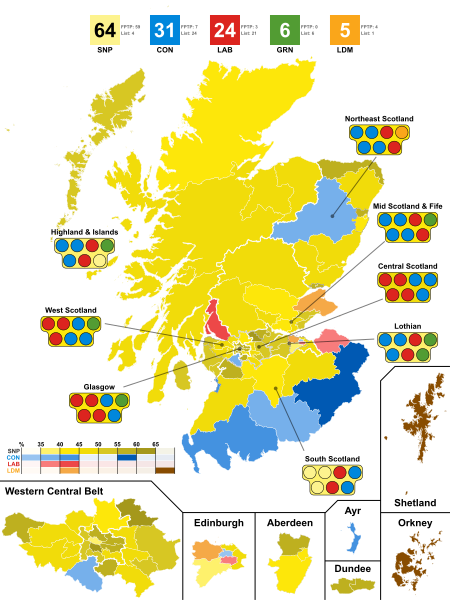
Back Eleccions al Parlament Escocès de 2016 Catalan Parlamentswahl in Schottland 2016 German Σκωτσέζικες βουλευτικές εκλογές (2016) Greek Elecciones parlamentarias de Escocia de 2016 Spanish 2016ko Eskoziako Legebiltzarrerako hauteskundeak Basque Élections législatives écossaises de 2016 French Taghadh Albannach 2016 Scots/Gaelic Elezioni parlamentari in Scozia del 2016 Italian Eleições legislativas na Escócia em 2016 Portuguese Scots Pairlament election, 2016 SCO
| |||||||||||||||||||||||||||||||||||||||||||||||||||||||||||||||||||||||||||||||||||||||||||||||||||||||
All 129 seats to the Scottish Parliament 65 seats needed for a majority | |||||||||||||||||||||||||||||||||||||||||||||||||||||||||||||||||||||||||||||||||||||||||||||||||||||||
|---|---|---|---|---|---|---|---|---|---|---|---|---|---|---|---|---|---|---|---|---|---|---|---|---|---|---|---|---|---|---|---|---|---|---|---|---|---|---|---|---|---|---|---|---|---|---|---|---|---|---|---|---|---|---|---|---|---|---|---|---|---|---|---|---|---|---|---|---|---|---|---|---|---|---|---|---|---|---|---|---|---|---|---|---|---|---|---|---|---|---|---|---|---|---|---|---|---|---|---|---|---|---|---|
| Opinion polls | |||||||||||||||||||||||||||||||||||||||||||||||||||||||||||||||||||||||||||||||||||||||||||||||||||||||
| Turnout | Constituency – 55.8% Regional – 55.8% | ||||||||||||||||||||||||||||||||||||||||||||||||||||||||||||||||||||||||||||||||||||||||||||||||||||||
| |||||||||||||||||||||||||||||||||||||||||||||||||||||||||||||||||||||||||||||||||||||||||||||||||||||||
 The map shows the election results in single-member constituencies. The additional member MSPs in the 8 regions are shown around the map. | |||||||||||||||||||||||||||||||||||||||||||||||||||||||||||||||||||||||||||||||||||||||||||||||||||||||
| |||||||||||||||||||||||||||||||||||||||||||||||||||||||||||||||||||||||||||||||||||||||||||||||||||||||
The 2016 Scottish parliament election was held on Thursday, 5 May 2016[1] to elect 129 members to the Scottish Parliament. It was the fifth election held since the devolved parliament was established in 1999. It was the first parliamentary election in Scotland in which 16 and 17 year olds were eligible to vote, under the provisions of the Scottish Elections (Reduction of Voting Age) Act.[2][3] It was also the first time the three largest parties were led by women.
Parliament went into dissolution on 24 March 2016, allowing the official period of campaigning to get underway. Five parties had MSPs in the previous parliament: Scottish National Party (SNP) led by First Minister Nicola Sturgeon, Scottish Labour led by Kezia Dugdale, Scottish Conservatives led by Ruth Davidson, Scottish Liberal Democrats led by Willie Rennie, Scottish Greens, led by their co-conveners Patrick Harvie and Maggie Chapman. Of those five parties, four changed their leader since the 2011 election.
During the campaign, a series of televised debates took place, including party leaders of the elected parties. BBC Scotland held the first leaders' debate on 24 March, STV broadcast the next on 29 March, and BBC Scotland hosted the final debate on 1 May.
The election resulted in a hung parliament with the Scottish National Party winning a third term in government, but falling two seats short of securing a second consecutive overall majority.[4][5] The Conservatives saw a significant increase in support and replaced the Labour Party as the second-largest party and main opposition in the Scottish Parliament. This was the first time that Labour had finished in third place at a Scottish election in 98 years.[4][5] The Scottish Greens won six seats on the regional list and overtook the Liberal Democrats, who remained on five seats.[4][5]
Although the SNP had lost their majority, it was still by far the largest single party in the Scottish Parliament, with more than double the seats of the Conservatives. Accordingly, Sturgeon announced she would form a minority SNP government. She was voted in for a second term as First Minister on 17 May.[6]
- ^ "Fixed-term Parliaments Act 2011, section 4". Archived from the original on 1 May 2016. Retrieved 14 January 2012.
- ^ "Cut in Scottish voting age passed unanimously". BBC News. 18 June 2015. Archived from the original on 7 April 2016. Retrieved 27 April 2016.
- ^ "Voting age in Scotland lowered to 16". About my vote. Archived from the original on 29 July 2016. Retrieved 27 April 2016.
- ^ a b c "New MSPs to arrive at Holyrood for first day". BBC News. 9 May 2016. Archived from the original on 9 May 2016. Retrieved 9 May 2016.
- ^ a b c "Election 2016: Before-and-after and party strength maps". BBC News. 6 May 2016. Archived from the original on 9 May 2016. Retrieved 9 May 2016.
- ^ "Sturgeon wins first minister vote". BBC News. 17 May 2016. Archived from the original on 17 May 2016. Retrieved 10 June 2018.




